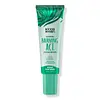What's inside
What's inside
 Key Ingredients
Key Ingredients

No key ingredients
 Benefits
Benefits

 Concerns
Concerns

 Ingredients Side-by-side
Ingredients Side-by-side

Water
Skin ConditioningPolyquaternium-46
Isobutane
Propane
Propylene Glycol
HumectantCetrimonium Chloride
AntimicrobialSodium Lauroyl Sarcosinate
CleansingOleth-20
CleansingPhenoxyethanol
PreservativeCaprylyl Glycol
EmollientEthylhexylglycerin
Skin ConditioningHexylene Glycol
EmulsifyingBenzophenone-4
UV AbsorberParfum
MaskingLinalool
PerfumingCitronellol
PerfumingHydroxycitronellal
PerfumingWater
Skin ConditioningGlycerin
HumectantCetyl Alcohol
EmollientLactic Acid
BufferingIsopentyldiol
HumectantHamamelis Virginiana Water
AstringentGlycolic Acid
BufferingVaccinium Myrtillus Fruit Extract
Skin ConditioningCitrus Aurantium Dulcis Fruit Extract
MaskingCitrus Limon Fruit Extract
MaskingAcer Saccharum Extract
Skin ConditioningCitric Acid
BufferingTartaric Acid
BufferingMalic Acid
BufferingMenthol
MaskingSea Water
HumectantLaminaria Digitata Extract
Skin ProtectingChlorella Vulgaris Extract
Skin ConditioningSaccharide Isomerate
HumectantLavandula Stoechas Extract
MaskingPropanediol
SolventLycium Barbarum Fruit Extract
AstringentCetearyl Alcohol
EmollientCeteareth-20
CleansingCaesalpinia Spinosa Gum
Skin ConditioningAcrylamidopropyltrimonium Chloride/Acrylates Copolymer
Isohexadecane
EmollientCoceth-7
EmulsifyingParfum
MaskingLimonene
PerfumingTetrasodium Glutamate Diacetate
Phenoxyethanol
PreservativeEthylhexylglycerin
Skin ConditioningWater, Glycerin, Cetyl Alcohol, Lactic Acid, Isopentyldiol, Hamamelis Virginiana Water, Glycolic Acid, Vaccinium Myrtillus Fruit Extract, Citrus Aurantium Dulcis Fruit Extract, Citrus Limon Fruit Extract, Acer Saccharum Extract, Citric Acid, Tartaric Acid, Malic Acid, Menthol, Sea Water, Laminaria Digitata Extract, Chlorella Vulgaris Extract, Saccharide Isomerate, Lavandula Stoechas Extract, Propanediol, Lycium Barbarum Fruit Extract, Cetearyl Alcohol, Ceteareth-20, Caesalpinia Spinosa Gum, Acrylamidopropyltrimonium Chloride/Acrylates Copolymer, Isohexadecane, Coceth-7, Parfum, Limonene, Tetrasodium Glutamate Diacetate, Phenoxyethanol, Ethylhexylglycerin
 Reviews
Reviews

Ingredients Explained
These ingredients are found in both products.
Ingredients higher up in an ingredient list are typically present in a larger amount.
Ethylhexylglycerin (we can't pronounce this either) is commonly used as a preservative and skin softener. It is derived from glyceryl.
You might see Ethylhexylglycerin often paired with other preservatives such as phenoxyethanol. Ethylhexylglycerin has been found to increase the effectiveness of these other preservatives.
Parfum is a catch-all term for an ingredient or more that is used to give a scent to products.
Also called "fragrance", this ingredient can be a blend of hundreds of chemicals or plant oils. This means every product with "fragrance" or "parfum" in the ingredients list is a different mixture.
For instance, Habanolide is a proprietary trade name for a specific aroma chemical. When used as a fragrance ingredient in cosmetics, most aroma chemicals fall under the broad labeling category of “FRAGRANCE” or “PARFUM” according to EU and US regulations.
The term 'parfum' or 'fragrance' is not regulated in many countries. In many cases, it is up to the brand to define this term.
For instance, many brands choose to label themselves as "fragrance-free" because they are not using synthetic fragrances. However, their products may still contain ingredients such as essential oils that are considered a fragrance by INCI standards.
One example is Calendula flower extract. Calendula is an essential oil that still imparts a scent or 'fragrance'.
Depending on the blend, the ingredients in the mixture can cause allergies and sensitivities on the skin. Some ingredients that are known EU allergens include linalool and citronellol.
Parfum can also be used to mask or cover an unpleasant scent.
The bottom line is: not all fragrances/parfum/ingredients are created equally. If you are worried about fragrances, we recommend taking a closer look at an ingredient. And of course, we always recommend speaking with a professional.
Learn more about ParfumPhenoxyethanol is a preservative that has germicide, antimicrobial, and aromatic properties. Studies show that phenoxyethanol can prevent microbial growth. By itself, it has a scent that is similar to that of a rose.
It's often used in formulations along with Caprylyl Glycol to preserve the shelf life of products.
Water. It's the most common cosmetic ingredient of all. You'll usually see it at the top of ingredient lists, meaning that it makes up the largest part of the product.
So why is it so popular? Water most often acts as a solvent - this means that it helps dissolve other ingredients into the formulation.
You'll also recognize water as that liquid we all need to stay alive. If you see this, drink a glass of water. Stay hydrated!
Learn more about Water